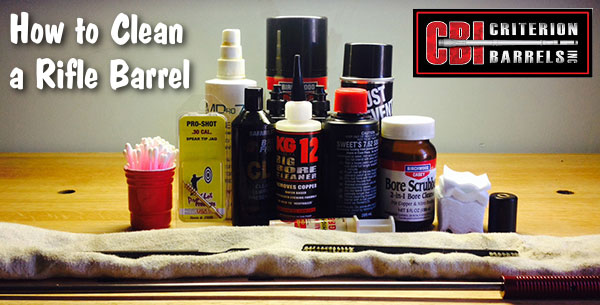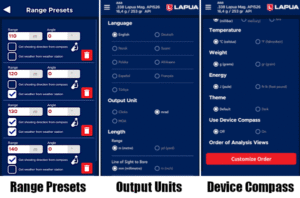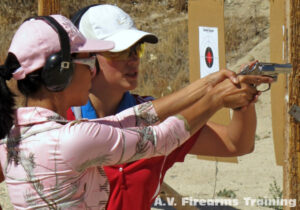This article is a Criterion Barrels publication. It offers good, conservative advice on barrel cleaning. Cleaning methods will need to be adjusted to suit the barrel and the type of fouling. We try to minimize brushing and follow the Criterion recommendations for respecting the crown/muzzle. We also have had great success with wet patches and Wipe-Out bore foam. You may also want to consider Wipe-Out foam, in addition to the methods outlined below by Criterion. To keep the foam from getting into the trigger assembly and action recesses, make sure you use a fitted cleaning rod boreguide. The video above shows how to use Wipe-Out or any other bore-cleaning foam. We use a slightly different approach. To remove carbon fouling, we first use 3-4 wet patches. Next, we apply the foam as illustrated, but usually starting at the muzzle (with bore guide in chamber). The important thing is that the foam should be applied again after the bubbles have subsided. This will allow more active ingredients to enter the barrel. After 3-4 hours, we patch it, as shown. What is the best way to clean a rifle barrel? This question is often asked along with requests for break-in procedures. Incorrect barrel cleaning techniques can lead to barrel damage or destruction, which can result in a loss of accuracy or even a catastrophic failure. There are many useful techniques for barrel maintenance that we haven’t listed. Different barrel types may require different techniques. This list of recommendations will include a variety of techniques that Criterion Barrels staff have used to great effect on their rifles. Feel free to add your own suggestions in the comments section. We recommend the following components for rifle cleaning: * Cloth patches (sized to the appropriate caliber).
* A brass jag properly sized for your bore
* One-piece coated cleaning brush
* General bore cleaner/solvent (Example : Hoppes #9)
* Copper solvent of your choice (Example: Sweets/KG12)
* Fitted cleaning rod bore guide
* Plastic AP toothbrush or toothbrush
* Q-Tips
* Plastic dental picks
* CLP (rust preventative type cleaner) There are many schools of thought about how often a barrel should need to be cleaned. To remove carbon, copper, and condensation build-up, we recommend that a barrel be cleaned at least once per shooting session. The most immediate danger is condensation, which can cause barrel rust while the rifle is stored. Copper and carbon buildup can negatively impact future barrel performance, increasing chances of a failure in feed and function. Fouling should always be removed. These tips will help reduce the wear on different parts of your barrel, thereby prolonging its life and improving its performance. The Grooves and Lands
This barrel could experience decreased efficiency due to copper fouling or cleaning rod damage. Check our barrel break in article if copper fouling occurs during rifle break-in. A single-piece coated cleaning rod is better than a traditional segmented rod. While bore snakes and segmented rods are convenient for field use the corners between segments can bow out and catch on the lands. This could cause a rifling line to be shortened. The barrel may become abrasive if grit or particles from the cartridges can get caught between the segments. Bore snakes can remove large amounts of carbon fouling but may not be able to remove residual carbon buildup or copper fouling during deep cleaning. While you can find good rods from many manufacturers, we have had great results using both Pro-Shot brand products and Dewey brand products. You should use patches for general cleaning, rather than nylon or brass bore brush. Brass brushes are sometimes required for more aggressive cleaning. However, they can cause excessive wear to the barrel if used often. This is not due the bristles themselves but the abrasive particles that are embedded in the material being repeatedly run through the bore. Bore guides are recommended for cleaning the muzzle and breech. Bore guides can protect the throat and crown from damage caused by cleaning rods. If the rod becomes resistant while being run through the bore, it should not be forced in any further. To determine the reason for resistance, take the rod out and inspect the barrel. The jag could be pushing between the bore obstruction and the drilling, digging a divot in the barrel, then pushing the obstruction back through its muzzle. A smaller area can be used to reduce the chance of a stuck rod. It is easy to clean the length of the rifle. Make sure that the rifle is unloaded.
2. Before cleaning, perform any necessary disassembly.
3. If possible, remove bolt and insert the fitted cleaning rod bore guide into action.
4. Boil a piece of skin in bore solvent (similarly to Hoppes #9).
5. Place the brass jag on the center and attach the patch to it, then insert it into the barrel’s chamber end. The jag may damage the lands of rifling if the patch is not properly aligned.
6. Then run the patch all the way around the barrel and then retract it when you reach the end of your muzzle.
7. Let the solvent sit for a moment.
8. Continue running patches through the bore, until carbon residue is reduced.
9. To ensure that carbon residue is removed, run a dry patch across the bore.
10. Make a small patch of copper solvent (Sweet’s or KG-12).
11. Run the patch through the bore and let it sit for 3-5 mins. *)
12. Continue this process until there is no more blue residue on the patches.
13. To neutralize the copper solvent, run a patch of Hoppes #9 through the bore.
14. Before assembling the rifle, inspect the barrel to ensure that there are no obstructions in the bore. *Please note that some copper-based ammonia solvents can be corrosive if they are left in the barrel for a prolonged period. To avoid destroying the bore, it is important that these solvents are removed within 15 minutes. The Crown
The crown is the area of the barrel where the bullet makes contact with the lands or grooves before it exits the firearm. The angle at which the bullet touches the bore of a barrel is critical for accuracy. To avoid damage to the crown, use a plastic toothbrush or CLP type cleaner to clean it from the barrel’s exterior. Barrel performance will be affected by even the smallest variation in crown wear. This is why it is important to avoid scratching or removing this area. Reduce Cleaning Rod Wear to Crown
Place the muzzle 1/4″ from a hard surface. This should be at an angle of the cleaning rod’s travel direction, such as a wall or edge of a bench. Retract the cleaning rod and take out the patch if the jag hits the hard surface. If the rod is bent or misaligned, the jag should be removed from the barrel before it can drag on the crown. The jag will still contact the barrel through the soft cloth patch, minimising any wear. Push the rod forward towards the muzzle, if possible, and insert it through the chamber. Some rifles, like the M1 Garand and M14, require that the cleaning rod be inserted through the muzzle. To reduce friction on the crown, a cleaning rod guide is recommended. For scraping carbon from the AR-15 barrel’s recessed muzzle, it is best to avoid using cleaning rod segments. This trick was used in the Marine Corps to impress NCO’s and armorers with the cleanliness of our muzzles. However, it likely had a significant impact on the rifle barrel’s service life. To remove any carbon or copper residue from an AR-15 barrel’s recessed muzzle, use a Q-Tip soaked with solvent. As long as the crown edge of the bore remains constant, any carbon residue on the muzzle’s face will not affect bullet travel. Cleaning the Chamber of the Barrel
A general cleaning process should include proper cleaning of the chamber. Carbon rings can form near the neck or throat of the chamber wall. This can lead to feeding problems and pressure spikes within the chamber. Because of its size fluctuations and the difficult ergonomics required to remove carbon residue, the chamber can be one of the most difficult parts to clean. Many chamber-specific devices have been developed to address this problem. Some should be avoided (steel Chamber brushes), but others can be very effective (cleaning stars, plastic dental picks). To clean a chamber, apply solvent to a few patches and then use the cleaning rod to spin any remaining patches within the chamber. This should help to remove any carbon. You can reach areas of the chamber that are not accessible by patches with a Q-Tip. The Barrel Exterior
Although firearm performance is dependent on the condition of the chamber, crown, and rifling, exterior finish should be cleaned after handling. Condensation, humidity and direct water contact can all lead to rust or corrosion. When storing a firearm in deep storage for a prolonged period of time, it is advisable to apply anti-corrosion products. [Editor: AccurateShooter.com recommends CorrosionX or Eezox. However, other products are also effective. Finding Cleaning Components While most cleaning parts can be found in your local gun shop or at a gun dealer, some items such as Brownell’s may require you to order them online. Criterion uses both Pro-Shot and Dewey cleaning components in its day-to-day operations. Do you have any other rifle cleaning tips and tricks that are not listed in this article? We would love to hear your tips and tricks. Post your comments below.
















